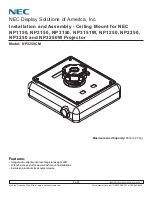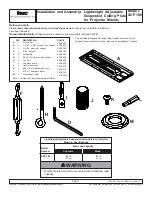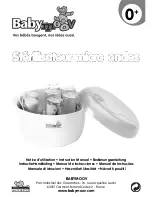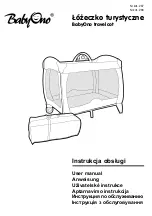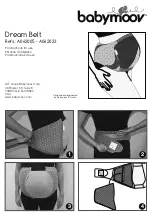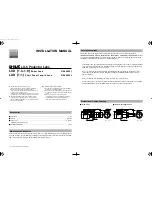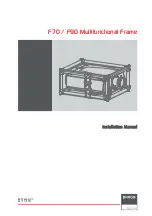
Instruction #1036057B - Page 10 of 11
IMPORTANT WARNINGS
AVERTISSEMENTS IMPORTANTS
Rack Installation
Inadequately secured loads and incorrectly mounted roof racks and
accessory racks can come loose during travel and cause serious
accidents! Therefore, installation, handling, and use must be carried
out in accordance with product and vehicle instructions.
In addition to these instructions, review the mounting instructions
for the roof rack and the operating instructions of the vehicle.
These instructions should be kept together with the vehicle’s
operating instructions and carried in the vehicle when in use and en
route.
For your own safety, you should only use roof racks that are
authorized for use with your vehicle.
For roof racks that do not specify the distance between the front
and rear crossbars, the distance shall be at least 700 mm or as large
as possible. Please note that changes (e.g., additional drill holes) to
the accessory rack’s attachment system are not permissible.
Check attachment hardware and load for tight fit and function:
• Before the start of any journey
• After driving a short distance following rack or load install
• At regular intervals on longer journeys
• More frequently on rough terrain
• After interruption of a journey during which the vehicle was left
unsupervised (check for damage due to outside intervention)
Rack Loading
Do not exceed the maximum load specified for the roof rack,
accessory rack or the maximum load recommended by the vehicle
manufacturer.
Max Roof Load = weight of roof rack + weight of accessory racks +
weight of load.
Load shall be uniformly distributed with the lowest possible center
of gravity.
Load should not substantially extend beyond the loading surface of
the roof rack.
Vehicle Driving and Regulations
The speed driven must be suited to the load transported and
to official speed limits. In the absence of any speed limits, we
recommend a maximum speed of 80 mph (130 km/h).
When transporting any load, the speed of the vehicle must take into
account all conditions such as the state of the road, the surface of
the road, traffic conditions, wind, etc. Vehicle handling, cornering,
braking and sensitivity to side winds will change with the addition of
rooftop loads.
If this product is off-road certified, it is designed and intended to
be used on forest service roads, access roads or other non-technical
terrains at moderate speeds. It is not to be used while rock-crawling,
jumping, bogging, or other technical off-road terrains. When using
off-road certified products with non-off-road certified products,
always follow the warnings and restrictions as stated in the non-
off-road certified product instructions.
Maintenance
The accessory rack should be carefully cleaned and maintained,
particularly during the winter months. Use only a solution of
water and standard car wash liquid without any alcohol, bleach, or
ammonium additives.
For reasons of fuel economy and the safety of other road users, the
accessory rack and roof rack should be removed when not in use.
Periodically inspect accessory rack for damage. Replace lost,
damaged, or worn parts. Use only original spare parts obtained
from a stocking specialist, dealer, or manufacturer.
Any changes made to the roof racks and accessory racks, as well
as the use of spare parts or accessories other than those supplied
by the manufacturer, will lead to the lapsing of the manufacturer’s
warranty and liability for any material damage or accidents. You
should observe these instructions to the letter and only use the
original parts supplied.
In order to replace any lost or defective keys, note the lock and key
numbers below and register them at www.yakima.com.
Pose du porte-bagage
Une charge mal arrimée, un porte-bagage de toit, ou encore un de ses
accessoires, qui seraient mal installés pourraient se libérer en cours
de trajet et provoquer un grave accident ! C’est pourquoi la pose, la
manutention et l’utilisation de ce produit doivent être conformes aux
instructions visant le produit et le véhicule.
En plus d’observer les présentes instructions, vérifier les instructions visant
la pose du porte-bagage et les instructions visant le véhicule.
Les présentes instructions devraient être jointes au manuel d’utilisation du
véhicule et conservées à bord lors du déplacement.
Par sécurité, on ne devrait utiliser que des porte-bagages qui sont
approuvés pour le véhicule.
Dans le cas des porte-bagages dont la distance entre les barres
transversales avant et arrière n’est pas spécifiée, cette distance doit
être la plus grande possible, mais d’au moins 700 mm. Prière de noter
qu’il est interdit d’apporter des modifications au système de montage de
l’accessoire (en perçant des trous supplémentaires, par exemple).
Vérifier la solidité des dispositifs de fixation et l’arrimage de la charge :
• Avant de prendre la route
• Peu de temps après le départ si l’on a posé le porte-bagage ou si on l’a
chargé
• À intervalles réguliers sur les longs trajets
• Plus fréquemment sur routes cahoteuses
• Après tout arrêt durant lequel le véhicule a été laissé sans surveillance
(confirmer l’absence de dommages provoqués par des tiers)
Chargement du porte-bagage
Ne pas dépasser la charge maximale spécifiée pour le porte-bagage,
l’accessoire de transport ou la charge maximale recommandée par le
constructeur du véhicule.
Charge maximale sur le toit = poids du porte- poids de
l’accessoire de tra poids de la charge.
La charge doit être répartie de manière uniforme et son centre de gravité
doit être le plus bas possible.
La charge ne doit pas dépasser significativement de la surface de charge
du porte-bagage.
Conduite du véhicule et réglementation
La vitesse à laquelle on roule doit tenir compte de la charge transportée
et des limitations de vitesse. En l’absence de limitation de vitesse, nous
recommandons de ne pas dépasser 130 km/h.
Quand on transporte n’importe quelle charge, la vitesse à laquelle on
roule doit aussi tenir compte des conditions ambiantes comme l’état de la
route, la surface de la route, les conditions de la circulation, le vent, etc. Le
comportement du véhicule, sa tenue en virage, son freinage et sa sensibilité
aux vents latéraux seront modifiés par l’addition de charges sur le toit.
Si ce produit est approuvé pour la conduite hors-route, il est destiné à
servir sur des chemins forestiers, des routes d’accès et d’autres terrains
peu accidentés à vitesse modérée. On ne doit pas l’utiliser si le véhicule
sert à franchir de gros rochers, à sauter, à rouler dans la boue profonde
ou à circuler sur des terrains très accidentés. Quand on se sert de produits
approuvés pour la conduite hors-route en conjonction avec d’autres qui ne
le sont pas, il faut toujours respecter les avertissements et les limitations
stipulés dans les instructions des produits qui ne sont pas approuvés pour
la conduite hors-route.
Entretien
L’accessoire de transport doit être nettoyé et entretenu avec soin,
particulièrement durant l’hiver. Pour le nettoyage, n’employer que du savon
liquide normal pour automobile et de l’eau, sans ajouter d’alcool, d’eau de
Javel ou d’ammonium.
Pour économiser du carburant et par sécurité pour les autres usagers de la
route, il est recommandé d’enlever l’accessoire de transport et le porte-
bagage quand ils ne servent pas.
Inspecter l’accessoire de transport régulièrement. Remplacer les pièces
perdues, endommagées ou usées. N’employer que des pièces d’origine, que
l’on peut se procurer auprès d’un détaillant ou du fabricant.
Toute modification apportée au porte-bagage ou à l’accessoire de
transport, ainsi que l’emploi de pièces ou d’accessoires autres que ceux
fournis par le fabricant, annulerait la garantie et la responsabilité du
fabricant en cas de dommages matériels ou d’accident. L’utilisateur doit
donc respecter les présentes instructions à la lettre et n’employer que les
pièces d’origine fournies.
Afin de pouvoir remplacer des clés perdues ou défectueuses, prendre note
du numéro de la serrure et des clés ci-dessous et les enregistrer à www.
yakima.com.












